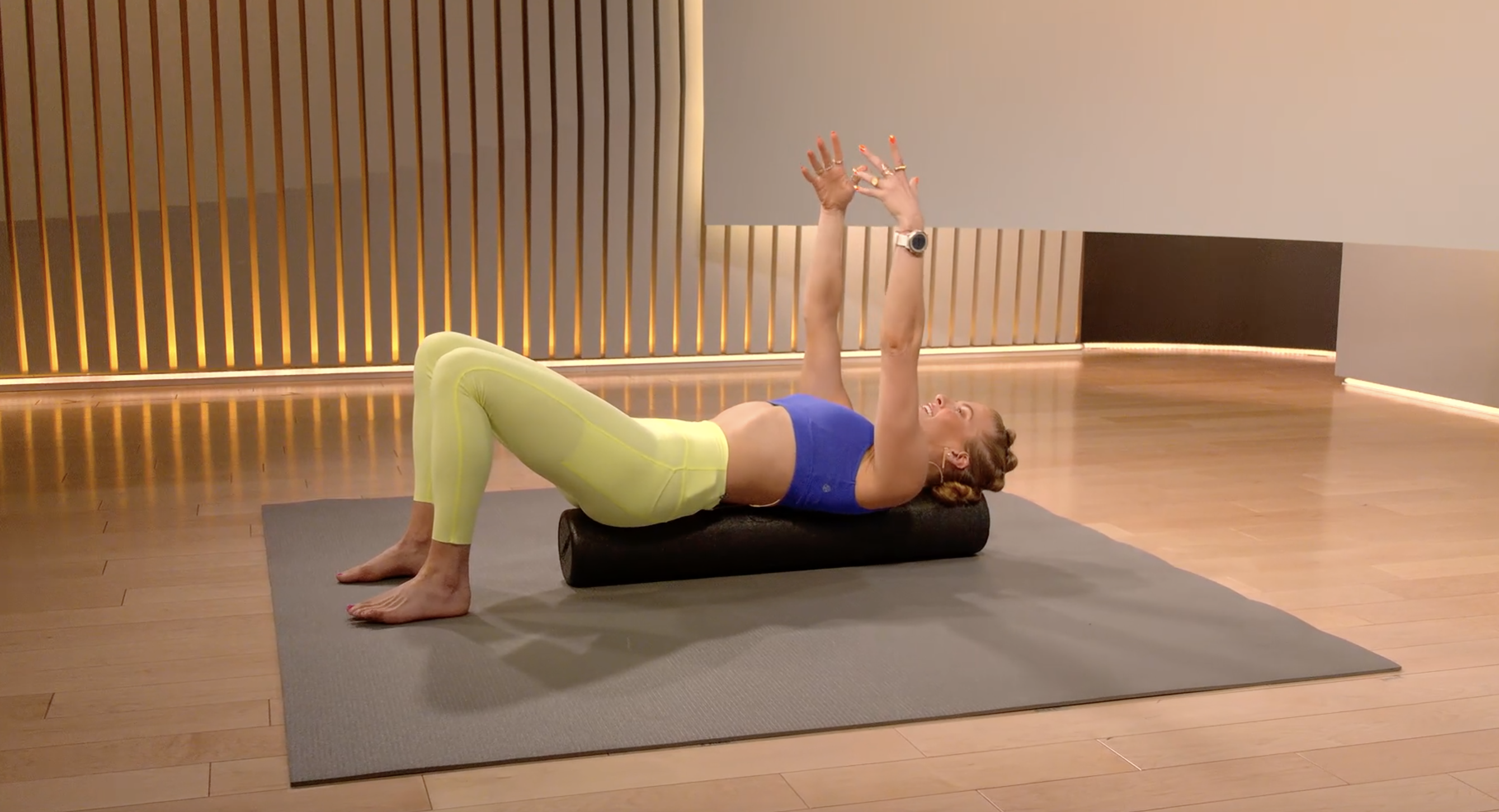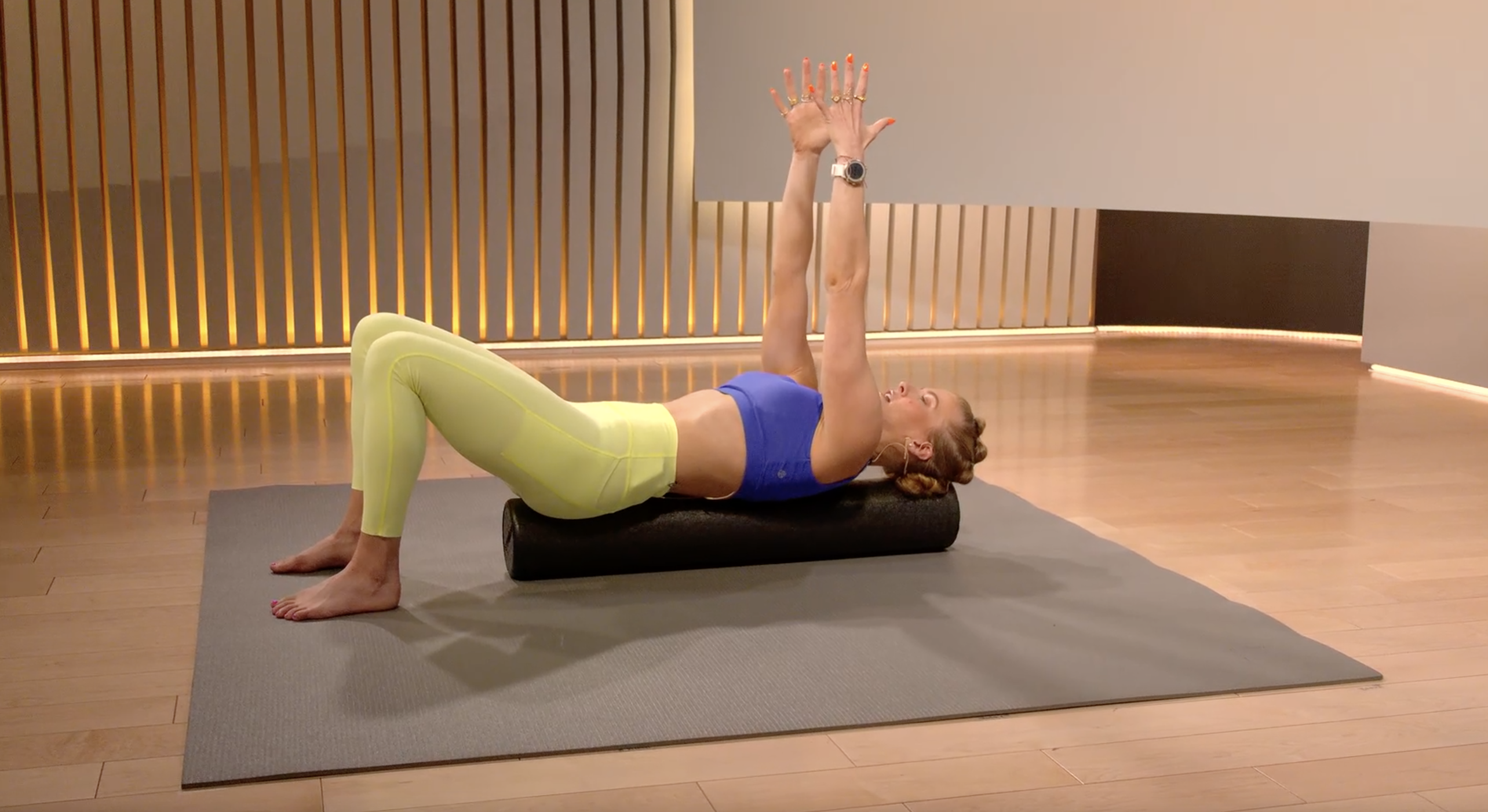
Achy Back Muscles? Try These 3 Foam Roller Moves
This recovery tool isn’t just for your legs.
By Colleen Travers•
What Is Foam Rolling?
Why Use a Foam Roller On Your Back?
Tips for Using a Foam Roller On Your Back
3 Foam Rolling Exercises for Your Back
If you’ve ever used a foam roller on your hip flexors, calves, or IT band you may have a love-hate relationship with this lightweight log. It only takes a few rolls to realize that—ouch!— it can hurt, but in a way that brings your muscles sweet relief a few minutes later.
Discover more ways to reach your goals with Peloton
One area that can benefit from a foam roller that you may be ignoring is your back. Read on for a look at why you should incorporate foam rolling your back into your stretching and recovery routine.
What Is Foam Rolling?
Foam rolling uses a cylinder foam tube to achieve what’s called a myofascial release. This is when you apply pressure (in this case, rolling certain muscle groups over the foam roller) to relax tight and/or stiff muscles.
“Foam rolling acts as a soft tissue massage, bringing more blood flow to your muscles to help reduce inflammation and relax tense muscles,” says Peloton instructor Rebecca Kennedy.
Why Use a Foam Roller On Your Back?
There’s little research to support why exactly foam rolling soothes back muscles, says John Fenger, DPT, physical therapist and manager of Outpatient Rehabilitation Services at MemorialCare Orange Coast Medical Center. Yet, both Fenger and Rebecca agree that if it makes you feel better it’s safe and worth taking the time to do it. Plus, there is research on the positive effect foam rolling has on muscle tension, so easing back muscle tension should be no exception, adds Fenger. Here are some other reasons foam rolling your back is beneficial.
It Helps with Delayed Onset Muscle Soreness (DOMS)
When you do a strenuous activity, or put a heavy workload (i.e., lifting heavy weights) on areas of the body that are new or not used to it, you may not feel a difference after your workout. Instead, you feel it the next day or a few days after. When this happens, it’s known as DOMS.
“DOMS happens when there are changes in connective tissue,” says Fenger. Putting heavy loads on the body causing tiny tears in muscle fibers. This is ultimately good—your body repairs those tears by making your muscles stronger. Before that happens, however, inflammation in the body increases and with it—some aches and pains.
“Foam rolling helps any damaged tissue and soreness that comes with it,” says Fenger.
Foam Rolling Helps Blood Flow
Research published in The Journal of Strength and Conditioning Research looked at adults between the ages of 23 to 27 who foam rolled the lateral surface of their thighs. Blood flow measurements were taken before the subjects started foam rolling, after, and 30-minutes post foam rolling. The researchers found that blood flow was higher immediately after foam rolling and 30-minutes after, compared to before.
Whether you’re foam rolling your legs or back, the targeted area will have the advantage of more blood flow, says Fenger. “An increase of blood flow means higher oxygen delivery to this area of the body, improving mobility and reducing soreness.”
How to Choose the Best Foam Roller for Your Back
“Using a 36-inch foam roller is my favorite because it can apply more pressure and support the full length of your body from head to tailbone,” says Rebecca. “Foam rollers with a softer cushion are great for beginners or if you need a gentler approach such as coming back after a recovery period or injury.”
It’s also important to pay attention to the density of your foam roller. Most foam rollers are 6-inches in diameter, and this is fine for all mobility levels. For beginners who want to start slow, Fenger recommends choosing a half foam roller that is three inches in diameter and flat on the bottom. This can allow for more targeted muscle work and will allow you to get used to foam rolling before moving on to more conventional foam rollers.
Tips for Using a Foam Roller On Your Back
Foam rolling can be a bit of an art form. You want to make sure you do it correctly to avoid discomfort and get the full benefits. Here are some things to keep in mind as you start implementing foam rolling into your routine.
Safety Tips for Using a Foam Roller On Your Back
Good news: foam rolling is a safe activity. But it’s a good idea to practice proper technique while you do it. Here’s how to protect your back muscles while using a foam roller to ease tension:
Roll slow: The only way to release muscle tension with a foam roller is to roll slowly. Blazing up and down won’t hurt you, per se, but you also won’t get the relief you’re looking for.
Avoid textured foam rollers: Some foam rollers come with knobs in the foam roller for a deep tissue massage approach. Unless you’re experienced with foam rolling, skip these types of foam rollers to start. They may be more intense to use at first, making you unable to slowly roll over tight spots.
Try side to side rolls: “Rolling against the grain of the muscle tissue can help promote pliability,” says Rebecca. If rolling up and down feels too intense this can be an alternative way to gently relieve back tension.
How Often/Long Should You Use a Foam Roller?
You can foam roll as often as you’d like, and it might take a few test runs to figure out when you feel best with foam rolling. Many people use it as a recovery tool, but it can also be an effective way to warm up, too.
“You can foam roll before or after a workout, or start with weekly foam rolling and increase from there,” says Rebecca. “Figure out when it makes you feel the most loose and relaxed—that’s how you know when and how often you should be doing it.”
As for how long to do specific exercises, follow the same guidelines as you would with stretching. Hold (or in this case, roll) any exercise for 30 to 60 seconds each. “You can also base it on your breathing,” says Fenger. “Do each move for 10 to 20 long breaths. If you have time, try to do two to four sets. For shorter sessions, do one rep of each move for 30 seconds.”
3 Foam Rolling Exercises for Your Back
Keep in mind that foam rolling is an effective way to stabilize your core at the same time. “Whether you’re foam rolling with a number of reps or doing static holds, engaging your core will help with foam rolling stretches,” says Fenger. “Plus, it will improve back discomfort on and off the foam roller by strengthening abdominal muscles to support the back during everyday movements.”
Ready to roll? These moves from Rebecca and Fenger will help release tension in the lower and upper back.

Foam Roller Exercise for the Lower Back
1. Place the foam roller under your butt on your sacrum (the bone at the base of the spine between the hipbones and pelvis) with your head, shoulders, and upper back on the ground.
2. Hug your knees into your chest and extend the opposite leg out straight, letting it hang down towards the floor. This opens the hip and relaxes the low back.
3. Make sure to keep the extended leg straight so the weight of the leg helps with release (bending at the knee won’t give this same feeling).

Upper Back Foam Roller Exercise
Sit on the ground and place the foam roller perpendicular to your spine a few inches below your shoulder blades. Tuck your pelvis under to feel your sacrum on the floor.
Cross your arms over your chest. Inhale, and as you exhale gently extend your spine over the foam roller arching only your mid/upper back while keeping your sacrum in contact with the floor.
Stay here and inhale again. Exhale as you try to go a little further.
For a deeper stretch, place your hands behind your head.

Lower and Upper Back Foam Roller Exercise
Lay your foam roller longways. Resting your butt, back, and head on the length of the foam roller, align your back straight along the foam roller.
Engage your core and raise your hands straight up.
Keeping your back in contact with the foam roller and not arched, pull your hands out wide, as if you are doing a chest press.
Bring them back up to starting position and repeat for time or reps.
For an added stretch, return with your arms straight up and keeping them straight, slowly bring them down toward the ears. As you do this, make sure the lower back stays in contact with the foam roller through the entire movement.
This content is for informational and educational purposes only and does not constitute individualized advice. It is not intended to replace professional medical evaluation, diagnosis, or treatment. Seek the advice of your physician for questions you may have regarding your health or a medical condition. If you are having a medical emergency, call your physician or 911 immediately.

Peloton App
Access thousands of classes with no equipment needed.
Related Articles — How to Use a Foam Roller on Your Back
This content is for informational and educational purposes only and does not constitute individualized advice. It is not intended to replace professional medical evaluation, diagnosis, or treatment. Seek the advice of your physician for questions you may have regarding your health or a medical condition. If you are having a medical emergency, call your physician or 911 immediately.
Level up your inbox.
Subscribe for a weekly dose of fitness, plus the latest promos, launches, and events.
By providing your email address, you agree to receive marketing communications from Peloton.
For more about how we use your information, see our Privacy Policy.








